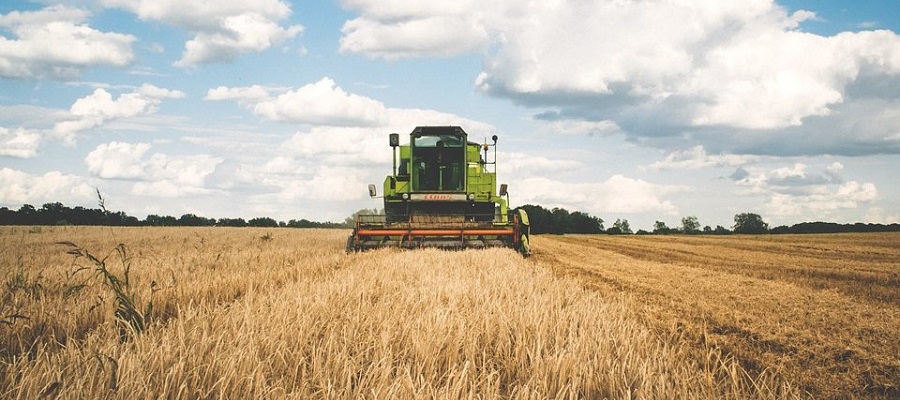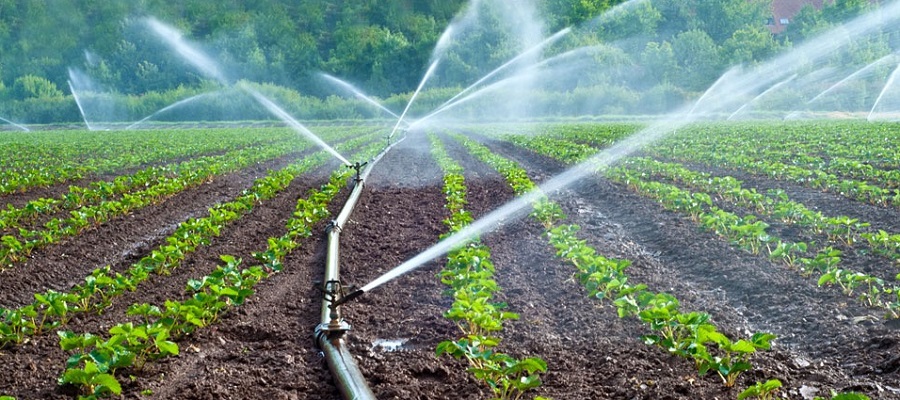Digital support in the harvesting process
The turnover of a farm or the supply of fodder ultimately results from the yield of the field. The following information should help to get an idea about the different fields of application of harvest workers.
Documentation
Field yield records
Yields should be documented after the harvest. Instead of writing it down by hand, today it can be done digitally and easily from a cell phone. This has the following advantages:
- Yields are documented in a comprehensible way (per field, further information possible)
- Yields are documented digitally in a field calendar or field index over the years, making deviations relatively easy to track
- Save time when entering data
Decision support
Yield estimation by digital photo
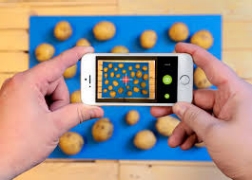
Taking a picture of a commodity - Source: sg.ch
With the SolGrader app, potato tubers can be recorded photographically and evaluated directly. Thus, the user receives information about important yield values already in the field, which is a valuable decision-making aid for producers. A 2-meter crop trial sample is sufficient to display the yield of a plot. The SolGrader app accurately displays the size distribution. SolGrader is a mobile application that allows you to analyze these samples directly on site using your cell phone and the blue mat. This data can be uploaded to a platform for further analysis and comparison.
Maturity status by satellites or drones
Satellite images from earth observation satellites
A contribution to precision agriculture is made by drones and satellites flying over fields from different heights. Their cameras detect the degree of ground cover or the type of vegetation. Every few days, satellites fly over the same spot. The serial images they take reveal how the plants are developing in which field. Evaluating these images with the help of "smart" algorithms can create new benefits. They can identify the growth rate or the threat of disease, the end of the row or even the optimum time for harvesting. And it can do so to within a few centimeters. Humans alone could not do all this.
Example of services through KWS:
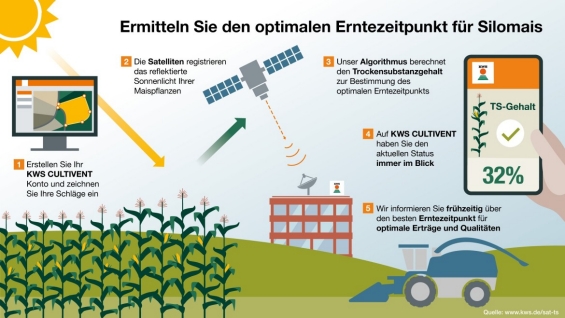
Satellite use in agriculture- Source: sg.ch
Drones capture biomass
Equipped with a camera or sensors, drones can be used to estimate biomass in agricultural grassland. Researchers at the University of Kassel have investigated this and found out: Compared to manual estimation via vegetation height, drone-based modeling estimates biomass just as well. In the experiment, the real yield was about 12 t/ha. The drone estimated the annual yield only 11% higher, whereas the manual height measurement was about 20% higher.
The drone has to fly over the area twice to estimate the yield: once without vegetation and then just before each harvest. A computer converts the photos from the digital camera. The difference gives the biomass. This also works for mixtures, the researchers found. The drone-based method estimates clover-grass mixtures even more accurately than alfalfa-based mixtures. It still takes a lot of time to account for the data. In the future, however, the drone-based method can save a lot of time compared to manual height measurement.
Yield mapping by satellite and growth models
The "TalkingFields" product assists in the management, documentation and planning of cropland. Three modules: Yield Map/TF Yield Forecast (actual yields), TF Yield Potential Map (long-term potential yields), and Crop Growth Model make up the so-called Talking fields. The yield of a crop is the result of daily biomass development over the entire growing season. Therefore, in addition to the satellite data, a plant growth model must be used to make statements about the yield of a crop at a location. The plant growth model takes into account hourly weather patterns as well as other influencing factors such as topographic location, soil conditions, etc. Example: Talkingfields
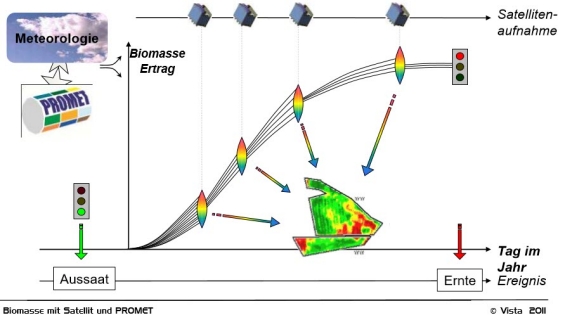
Satellite and growth models - Source: sg.ch
Moisture measurement with mobile device
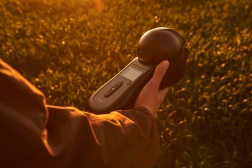
GrainSense - Source: sg.ch
One of several options for moisture measurement are mobile moisture meters, which can be ordered via the Internet. These are reliable, provided they are calibrated beforehand. Due to the high variability in one day, in critical cases daily measurements should be taken in order not to miss the best possible harvest time.
An innovative mobile device from Finnish company GrainSense for measuring grain quality, provides information on ingredients within 30 seconds. This includes protein, oil and carbohydrates, as well as the moisture content of common cereals. Results are sent to an app for mobile access at any time. GrainSense is the first affordable and outdoor-ready grain quality measurement device for farmers.
Height and mass measurement

A herbometer - Source: sg.ch
Rising height meters, also known as herbometers or rising plate meters, have proven their worth in pasture management. The function is very simple: a rod stands on the ground and a movable plate rests on the growth. The difference is the height of the growth.
From Ireland now comes the Rising Plate Meter with digitalization potential. The Rising Plate Meter connects via Bluetooth to a corresponding app on the smartphone. The user can now measure the pasture area or draw it in on the PC via the web version. If the farmer now measures the emergence on the area, the app saves the value on a GPS position. It also converts the yield as fresh mass/ha. To do this, you have to walk the area representatively, i.e. in a zigzag. In this way, the yield of the entire pasture area can also be analyzed.
Together with the number of grazing cows, the app can create a grazing plan. In this way, Grasshopper serves as a management tool. If you also measure the forage residue of the pasture (post-grazing), the app calculates the net grazing yield and thus the profitability. For intensively managed, German ryegrass-dominated stands, Grasshopper already provides reliable data. In Schleswig-Holstein, a project is currently underway to adapt the data for grazing under the local climate. The goal: to measure grazing yield via app, using only site and weather data.
Harvesting technology
Asparagus: automated harvesting solution for white asparagus
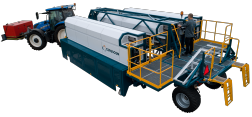
A harvesting solution - Source: sg.ch
To cut the asparagus correctly at the right length requires some experience.
Cerescon uses a unique patented detection method in which advanced proximity sensors detect asparagus underground without touching it themselves. An extremely fast-acting retraction mechanism prevents contact with the asparagus. The result: the asparagus remains undamaged. The coordinates of the asparagus are then passed on to a piercing robot. Furthermore, the machine is automated in such a way that it stabs the asparagus and then closes the dam again.
Strawberries: Robots for gentle harvesting
Strawberry pickers are still hardly mass-produced on the market.
A Spanish company AGROBOT S.L. has presented a first fully automatic strawberry harvester. It is said to make it possible for a single worker to harvest an entire strawberry field. Inductive sensors control the robotic arms, while robust ultrasonic sensors navigate the harvester and ensure a safe distance between the robotic arms and the ground. A camera system ensures that only ripe berries are harvested. The end effector itself does not come into contact with the fruit. Therefore, it cannot damage the strawberries; it only grabs the strawberries by the stem, cuts them off and places them in a box.
The Belgian company Octinion is also developing a picking robot. The Rubion automatic harvesting robot can drive through the greenhouse, select ripe strawberries and pick them without damaging them. Finally, it can sort the strawberries into the final packaging. The peculiarity: he selects the fruits only if his action does not bruise the strawberries. He picks without damage 70% of all ripe strawberries. Uses 3D vision to detect and locate ripe strawberries. With a patented soft touch gripper, the fruit is picked without a stem.
Another product is "Dogtooth". It is geared to the table-top systems of traditional British varieties that are widespread in the UK and is set up to pick strawberries with a stem. Computer vision is used to identify the ripe fruit. After picking, the robot autonomously sorts the berries to determine their size and quality and places them directly into baskets.
other products:
Compact self-propelled combine harvester
A compact combine harvester with crawler tracks was developed as a pilot project by the Dutch harvesting specialist HuizingHarvest/Agrobotix. The FieldBee application was contributed by eFarmer. The driverless machine has already been used in the Netherlands for barley threshing.
The cutterbar width of the compact combine is 2 m with a total weight of around 3.5 t and a grain tank capacity of 1 m3. In autonomous operation, the combine achieves a threshing capacity of up to 0.6 ha per hour.
This compact combine design was chosen to implement a soil-friendly threshing concept, says Agrobotix. All combine functions run completely autonomously and can be monitored by the operator via smartphone app and controlled if necessary.

self-propelled harvester - Source: sg.ch
Analysis
Online yield measurement
The digitization of agriculture in the area of harvesting technology and the associated logistics is made up of various elements.
The first stage is high-performance harvesters equipped with sensor technology. The combines have various sensors and record yield and grain moisture by measuring the amount of grain. Loss sensors record the load on the separating and cleaning equipment, indicating changes in the harvesting process. Overshoot sensors sense the mass of overshoot (BÖTTINGER 2008). During yield data collection, local yields, GPS data, grain moisture, losses, rotation speed, and date and time are recorded and stored. These data can be transferred to a PC after harvesting by means of a USB stick or online from the yield monitor on the combine (NOACK 2007 p.15). Yield maps can then be created from this data.
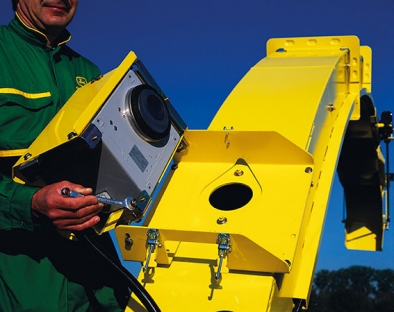
Yield measurement - Source: sg.ch
Quick analysis method with NIRS
NIR is the abbreviation for Near Infrared. Near InfraRed Spectroscopy (NIRS) is a physical method for the determination of (mostly) organic molecular compounds. NIR spectroscopy works with light between approximately 800 and 2,500 nanometers in wavelength. This light is not visible to the human eye, but can only be felt as thermal radiation. Advantages of NIR spectroscopy are the simple and clean handling and the fast and comprehensive data delivery.
The basis of NIR technology is that substances and thus molecules are irradiated with near-infrared light. Part of the light is absorbed, another part is reflected. The more light-absorbing molecules there are, the less light is left for reflection. A measuring apparatus measures how much light per wavelength the sample material reflects. The result is a reflection pattern - the so-called NIR spectrum. From the reflected spectra, information about the molecular composition can be read. These spectra are evaluated and interpreted with software that uses mathematical, statistical and chemometric methods.
Overview agricultural applications with NIRS technology in practice
- Dry matter determination of silage corn and green forage (forage harvester)
- Determination of ingredients (starch, protein, crude fiber, etc.) of silage corn and green forage (forage mixer)
- Content determination and discharge of slurry and digestate (TS, NH4-N, P2O5, K2O)
- Harvest time determination of silage maize
- Analysis according to ingredients for feeding (e.g. in TMR - total mixed ration)
Advantage
- Results are available immediately (according to demand)
- Variety of ingredients can be determined for internal operational management
- Suitable for a wide range of media (liquid, solid)
- High sample throughput
- Reduced sampling error with automatic measurement in the good stream
- Simplified documentation (optional)
- Estimation of nutrient changes in the (settled) slurry tank (e.g. thick slurry, natural sedimentation)
Disadvantage
- Expert knowledge required (plausibility check)
- High inaccuracy as soon as out of calibration
- Calibration approval not given (estimated values instead of measured values)
- High investment costs
- Regular manufacturer updates
- There is currently no national, technical recognition of the system
Wildlife protection
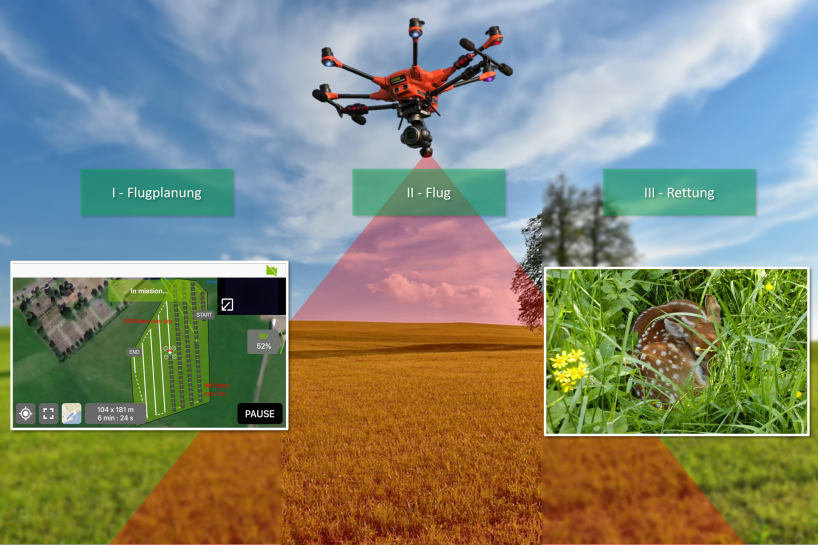
Wilf life protection - Source: sg.ch
There are basically two reasons to avoid by all means that e.g. fawns get into the grass mowing. It is necessary to protect the life of the young game and because further also the botulism bacteria developing from carcasses can become the deadly danger for the own cattle.
Drones equipped with thermal and real-image cameras are also used. These fly at an altitude of 30-50 meters to scan a meadow with tall grass according to programmed flight paths. In case of conspicuousness, it is then possible to spontaneously switch to manual control and to lower the flight altitude for detailed images. The search is most successful in the early morning, when the ground is still cool and the temperature differences between animal and environment are significant.
Procedure for use
The approach is always in teams of two, with one drone pilot and one "rescuer". The drone pilot flies systematically over the field. The locations where corresponding heat points are found are marked. After the entire field has been flown over, the pilot navigates the drone again to each point individually to verify that the object found is indeed a fawn. If a fawn is identified as such, the drone stops there over the field and the rescuer runs into the field to the fawn. Thanks to the drone in the air, he has a good point of orientation. In addition, the rescuer has a screen with him on which he can see the live images from the drone. This way, he can tell when he is approaching the fawn. The fawn is either carried to the edge of the field and covered with a box there or at the place where it was found.
When using drones, the applicable rules and legal requirements regarding insurance; flight bans and flight permits must also be observed.
References
